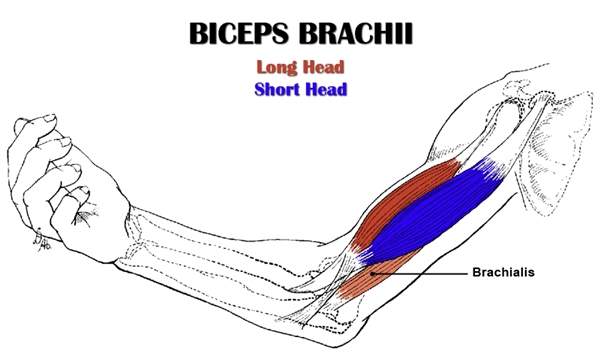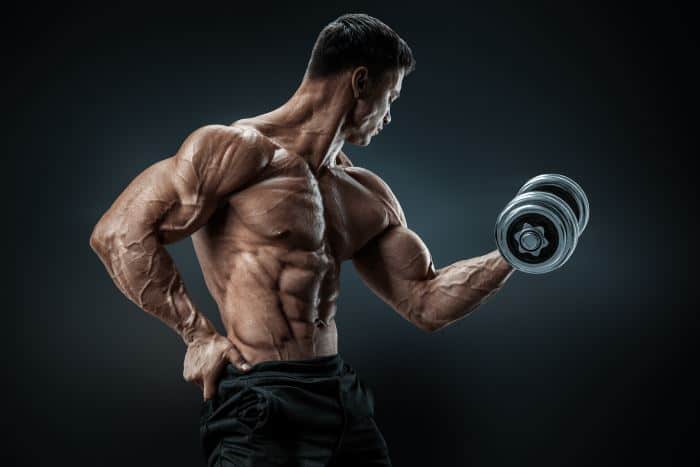The biceps anatomy includes the biceps brachii and the brachialis. Learn about both of these muscles, their locations and functional anatomy.
This page contains an overview of the biceps muscle group.
A little known fact is that the biceps muscle group only make up one-third of the upper arm’s muscle. The triceps brachii is actually twice its size, accounting for the remaining two-thirds of muscle mass. That said, let’s look at the makeup of the biceps…
Biceps Brachii & Brachialis

Biceps Brachii
The anatomical name for the main biceps muscle is biceps brachii, which is in Latin. Translated to English, biceps means “two-headed” and brachii means “of the arm.” It doesn’t take a genius to figure out the combined translation: “two-headed [muscle] of the arm.”
The two heads (i.e. distinct collections of muscle fibers) of the biceps anatomy vary in length, and so, they are known as the short and long biceps heads. They connect to different places on the shoulder/scapula region, but have a common insertion point on the elbow tendon.
This unique structure allows the biceps to carry out their two essential functions:
- Elbow Flexion. Bending the arm at the elbow joint. An example of this is when you do a class arm flex to try to impress your friends.
- Forearm Supination. Rotating the forearm and hand from side to side. An example of this movement is turning a key to unlock the door.
- Curling and Pulling. Unlike most muscles on the front of the body, the biceps are involved in pulling and curling movements as opposed to pushing and pressing movements or exercises. Examples of exercises that work the biceps brachii include barbell curls, barbell bent over rows and pull ups.
Brachialis
There is another arm muscle typically associated with the biceps muscle group. It is the much less known muscle called the brachialis…
…But being relatively unknown doesn’t mean it’s unimportant, as is the case with many things in the fitness world. The brachialis, which is located underneath and on either side of the biceps brachii, assists in the action of elbow flexion.
Unlike the biceps brachii, the brachialis does not contribute to forearm supination. Instead, it is a pure elbow flexor, solely responsible for bending the arm at the elbow joint. While the brachialis is engaged during the same exercises as the biceps brachii, it does not receive additional activation from the supination that occurs during curls.
Interestingly, the brachialis allows people to bend their elbows even if they completely rupture their biceps brachii. This is important because some individuals opt not to have surgery for a biceps rupture, whether due to age, lifestyle, or other personal reasons.



Hi Sir,
please guide me to build biceps & triceps.
i am doing workout for last 1 year.
Discontinued in between for some time.
Now i am back.
Check out this article I wrote on how to build bigger biceps.
What do you mean by the Brachialis being involved when the arm isn’t moving, like at the end range of a bicep curl, you keep your bicep flexed and if you then performed a row that would target the brachialis? Also is the Brachialis more involved when you use a neutral grip, instead of a supinated grip? I’m asking because I’ve been watching armwrestling recently and want to get into armwrestling.
Hi Michael, sorry about that and thanks for bringing it up. I think I mis-wrote that when originally creating this page years ago. I’ve updated the page to fix it. Essentially, I was trying to say that the brachialis isn’t involved in supination like the biceps brachii is.
Regarding your question about the brachialis’ involvement in a neutral vs supinated grip:
Yes, the brachialis is more involved in a neutral grip compared to a supinated grip, but in two ways. First, relative to the biceps brachii, the brachialis plays a larger role in elbow flexion with a neutral grip because the biceps are in a mechanically weaker position.
This means the brachialis takes on more of the workload compared to a supinated grip, where the biceps are more active. Second, relative to itself, the brachialis is always highly active in elbow flexion, but it may experience slightly greater activation in a neutral grip simply because the biceps contribute less, requiring the brachialis to work harder. However, it remains the primary elbow flexor in all grip positions.